
Riding the New Rocky Mountaineer U.S. Route from Denver, Across the Rockies, to the Red Rocks of Utah
By Rich Grant
GoNOMAD Senior Writer
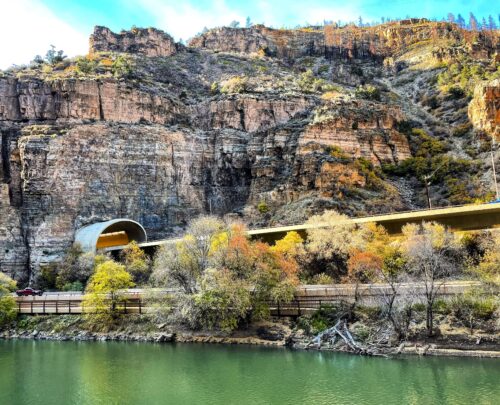
As the train entered the first tunnel, all 50 passengers in our car let out a collective sigh of amazement. What an incredible illusion!
We had just raced from bright Colorado sunshine into complete darkness. But at the exact moment we entered the tunnel, the darkness disappeared and lights all around the modern rail car lit up, creating the sensation that we were in some fantastic rocket ship, hurtling through a deep, dark hole cut into the earth.
50-Mile View
Then there was a glimmer ahead, and suddenly, the inside lights were gone and we were back outside in Colorado sunshine, light filtering in through the partial glass roof while to one side we could see 50-mile views out onto the plains, just visible through breaks in the pine trees.
The first tunnel caught us by surprise, but we were prepared for the next. Within 40 minutes, we would blast through 28 tunnels as the rail line followed a contour along the Rocky Mountains west of Denver, feinting here, dodging there, always searching for a way to break through the wall of mountains and head west.
Finally, high above Eldorado Canyon, the rails made their final turn left and we were climbing and climbing, high into the foothills of the Rocky Mountains.
A Train Ride Like No Other
It’s a section of the rail line known as “Tunnel Alley,” and though I had ridden it in trains 20 times, I had never experienced it quite like this. Not many people have. The famous Rocky Mountaineer railroad of Canada, one of the great luxury railroad lines of the world, had in August 2021 just opened its first U.S. rail journey traveling between Denver, Colorado and Moab, Utah, and I was among the first few to experience it. How long is the Rocky Mountaineer train trip? ‘Two glorious days!
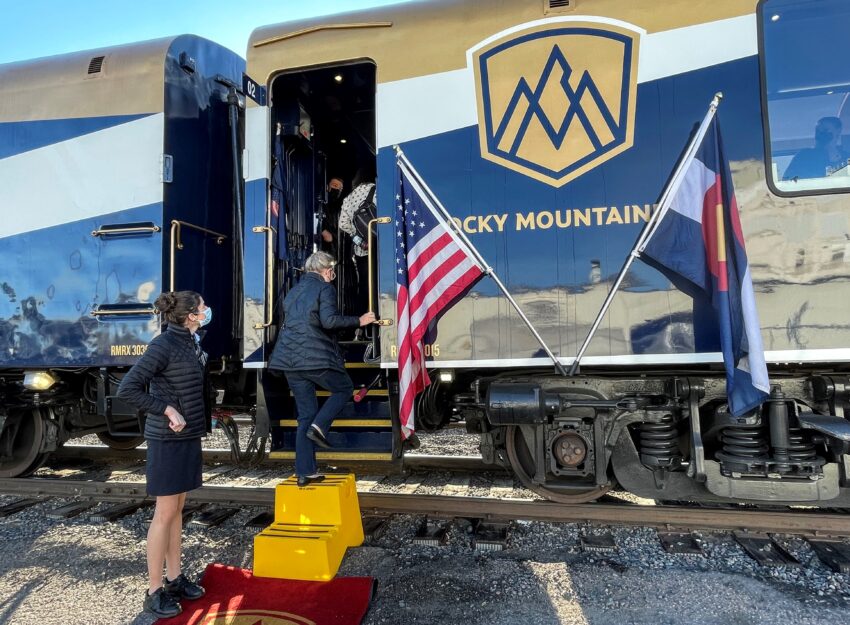
Titled “The Rockies to the Red Rocks,” the new luxury train carries passengers from the Great Plains, climbing past snowcapped peaks to burrow under the Continental Divide and come out at the headwaters of the Colorado River. The tracks then follow down one canyon after another until it ends in the fantastic great red rock arches and canyonlands of Utah. Or vice versa. You can start and end your journey in either direction.
But wait! Those of you who know railroading in the West will say, “There are no passenger rail lines to Moab!” And you’d be correct. Though railroads were built to Moab in the days of the uranium mining boom, they never carried passengers.
This is what makes the Rocky Mountaineer so great. They have opened up more than 20 miles of track through red rock canyons that rail passengers have never experienced before.
The Backstory
In 1990, Canadian Peter Armstrong created the first Rocky Mountaineer – a luxury two-day rail trip between western Canada and the Canadian Rockies. The concept was different than other rail travel: the ride was not about getting somewhere, it was about the journey.
The train would only travel during daylight hours. It would travel at just 30 mph and even slow down in the most scenic areas. Passengers would ride in luxury and comfort in dome cars, eat wonderful cuisine, and drink based on the region as they enjoyed the constantly changing scenery flashing by.
The idea was a sensation.
Today, the Rocky Mountaineer is the largest privately-owned luxury railroad in the world with 44 deluxe rail cars, nine locomotives, and a history of having carried more than 2 million passengers. Having achieved huge success in Canada, in August 2021, after years of planning, the Rocky Mountaineer added a new United States route to their three Canadian trips.
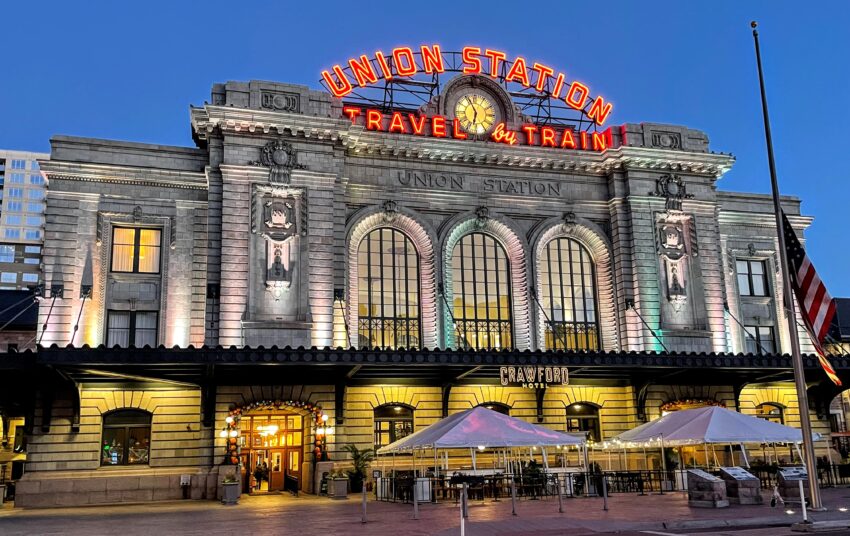
What’s it like Riding the Rocky Mountaineer? Do you sleep on the Rocky Mountaineer?
DAY 1: DENVER TO GLENWOOD SPRINGS
Prior to boarding, all passengers spent the night in a selection of boutique hotels surrounding the hip, revitalized Union Station area of Denver. I was in the Oxford Hotel, Denver’s oldest hotel dating back to 1892, and joined other fellow passengers in the lobby for morning coffee in front of a wood-burning fireplace. You sleep in luxurious hotels at your destination on this train ride, not on the train.
In 2021, it was necessary to take a short motorcoach ride to the train, which hopefully will be able to pull right into Union Station next year. Rail cars on the U.S. route are what the railroad calls “Silverleaf class.” Seats are assigned and resemble first-class seats on an airline: four across, two-by-two with a center aisle in cars that hold 56 passengers. Everyone will travel and eat in the same seat.
Air Travel has Nothing on Train Rides

But unlike air travel, the seats are spacious. Extending my arm, I could not touch the seat in front of me. Since the cars are 14 feet high without overhead luggage, you can easily stand up at any time, and there is a great feeling of openness with light pouring through oversize windows on the sides and partial windows on the roof.
It’s as close as you can get to being outside. But if you want to be outside, you can stand in the vestibule between your car and the lounge car where the windows are open and fresh air pours in. Don’t try doing that on a plane.
Before the train departs, there are white tablecloths on every pull-down tray, warm croissants, fruit, and coffee. The second the train departs at 9 am, the bar opens, and even though the average age of passengers is 65, there is an impressive amount of bloody marys and mimosas traveling down the aisle.
Just Keep Eating
In 2021, the requirement was you had to wear a mask on the train except while eating and drinking. Easy solution: we were always eating and drinking!
The largest difference from airline travel (other than the obvious fact you are on the ground) is that there are four or five hosts in sharp, navy-blue uniforms assigned to your car. You are going to spend 14 waking hours with them, in near-constant contact, as they serve meals and drinks and provide storytelling and other services.
Everything is on a first-name basis. Mike, our primary host, was a historian and comedian who knew every inch of the rail journey and added greatly to the trip. Leigh, the bartender in the lounge car, was funny and a delight and had no problem keeping gin and tonics going as we sailed past one incredible viewpoint after another.
And it’s the scenery, of course, that in the end makes the trip.
The Route
The first day follows the old Ski Train route from Denver to Winter Park, familiar to many on board including our host Mike who had ridden it dozens of times. The entire route to Glenwood Springs is on the same tracks as AMTRAK, but a world away in atmosphere.
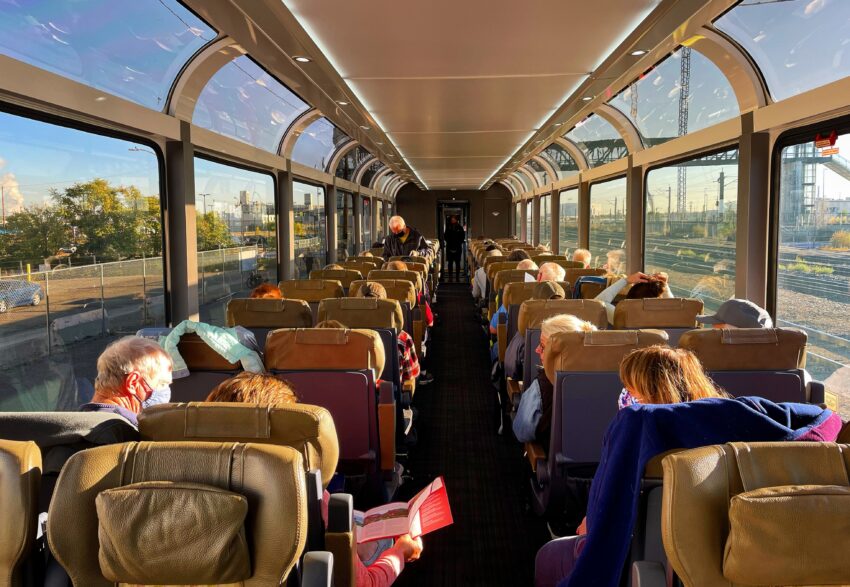
Beautiful maps at every seat let you follow the journey through the Moffat Tunnel and down canyons almost unknown like Byers, Gore, and Burns, finally coming out in Glenwood Canyon. There, the road highway was famously closed for two weeks in 2021 by a landslide, but the railroad continued to sail through.
Even in October, as you glide along the Colorado River, almost every person you pass on a raft will stop to “moon” the train. Mike, who claims a photographic memory, counts 67 as the most moonings seen from the train in a single day. We saw about a dozen, though we did also see deer, pronghorn, and a bald eagle.

Stopping in Glenwood Springs
When the train pulls into Glenwood Station, your luggage (left in your room in Denver) is already in your new room here.
It’s a short walk to historic hotels like Hotel Colorado or the Hot Springs Resort & Spa, where I stayed. Glenwood Springs is a wonderful historic town and every time I am there, I wonder why I am always on my way somewhere else. There’s a restaurant row, several breweries, and beautiful back streets lined with historic homes.
Most train passengers duck into the world’s largest hot springs pool, the Glenwood Hot Springs Pool, Resort & Lodge, but I needed to stretch my legs. So I climbed alone high above the town to the grave of the famous gunslinger Doc Holliday.
Poor Doc died here, penniless, and was given a pauper’s grave. But his name lives on in everything you can give a name to, from saloons to motels.
No one knows exactly where he’s buried, but a historic marker gives Wyatt Earp’s famous quote about his friend: “He was the most skillful gambler and the nerviest, fastest, deadliest man with a six-gun I ever saw.”
DAY 2: GLENWOOD TO MOAB
The next morning, it’s “up and at ‘em” at 6:30 a.m., since the train departs at 7. The early departure is a bonus in mid-October because it’s dark at the station when we pulled out. But, a half-hour later, the sky turns a brilliant pink, orange, and lavender as the sun rises. The car floods with golden light, and everyone jumps from their seats to photograph the colorful reflections on the Colorado River beside us.
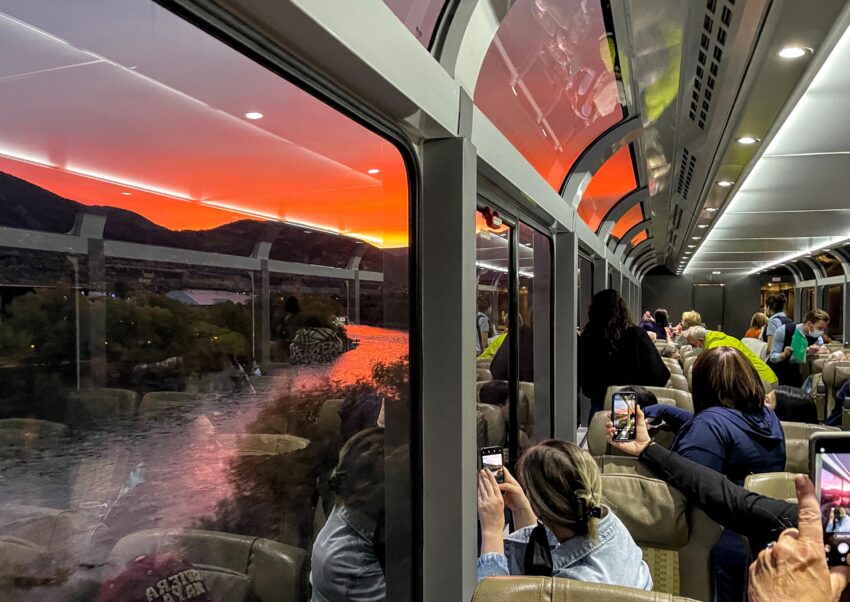
Breakfast has already been served. The meals are all first-class quality with regional ingredients: farm-fresh scrambled egg Cazuela with crumbled cotija, corn tortilla chips, turkey sausage, and roasted Hatch chiles for breakfast; Rosemary & Durango honey-roasted pork loin for lunch.
In Canada, the railway has double-decker cars with the meals cooked on board; passengers ride on the top level and go to the bottom level for meals. Because the tunnels in Colorado are too low, the double-deckers will not fit, and so prepared meals are served at your seat. I think I would prefer it that way because it would be difficult to leave the panoramic views.
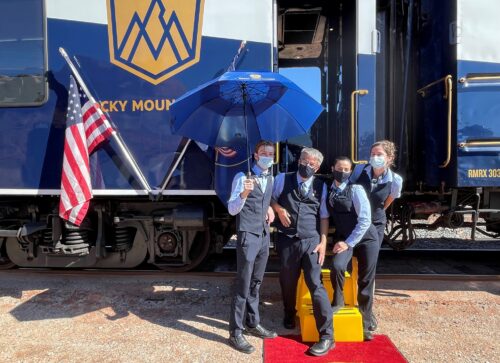
Challenges of Train Travel
Another reason the train leaves so early involves the enormous logistics of running a railroad in the Rocky Mountains.
Five motorcoaches have always followed us from Denver, carrying the luggage and providing backup if needed. When you see how narrow the canyons are and how many rocks hang above the tracks, you can understand the need for backup.
Although in 2021 it was the highways that closed due to landslides, not the railroad. Rockslides ahead are always a possibility.
Another challenge is that this will be a 17-hour workday for the crew. The challenge: engineers cannot work that long. So one team of engineers will guide the train from Glenwood to Grand Junction.
A second team will take the train to Moab, turn it around, and bring it back to Grand Junction. Then, the first team will take it back to Glenwood. Your hosts in the car must work the full day, both directions.
But we, the passengers, don’t have to do a thing except sit back and enjoy the view. We nibble on Charcuterie and cheese, plates of bison, elk, and venison with a nice red wine as we cross the state border and enter ever-increasing red rock canyons of Utah.
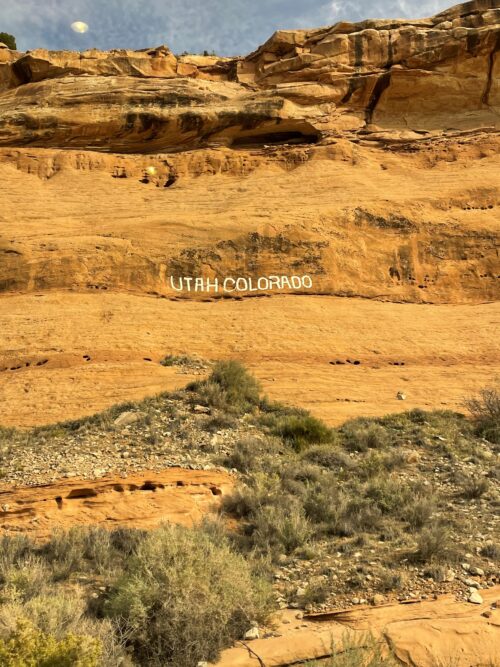
Next Stop: The Middle of Nowhere
Then around noon, the train stops, in the middle of nowhere, seven miles from Moab. Those who have booked excursions will be picked up here in vans to go to Deadhorse State Park and Canyonlands National Park.
Motorcoaches take others straight to Moab to rent cars or fly on to Salt Lake or back to Denver.
Adventure Ahead
While there was still spectacular scenery and adventure ahead, it was a bit sad to leave the train. It was not just the luxury, food, open bar, and service, though that was all wonderful. There’s a comradery in train travel. Though all strangers, we became friends.
There’s nothing like exchanging stories about travels in faraway places while you are standing in the vestibule between cars click-clacking your way through the Rocky Mountains. Not many travel amateurs ride the Rocky Mountaineer. We few aboard were all experienced travelers.
No doubt, many of the two million who have taken the train through Canada will now have to experience the U.S. version. They certainly will not be disappointed.
The Stops
Denver is exploding with a thousand new residents a week, and no part of the city is more exciting than around Union Station.
The city is experiencing an art renaissance with a major new expansion of the Denver Art Museum and $54 million worth of new theatres at the Denver Performing Arts Complex.
Plus, there’s a brand new Meow Wolf.
(If you have to ask what this is, it may not be for you. Let’s just say the five-story, interactive art experience is exactly what you would expect to find in the first city in the world to legalize recreational marijuana.)
Don’t miss Rockmount Ranch Wear, the snap-button Western shirt clothing outlet for rock stars, just a block from the station.
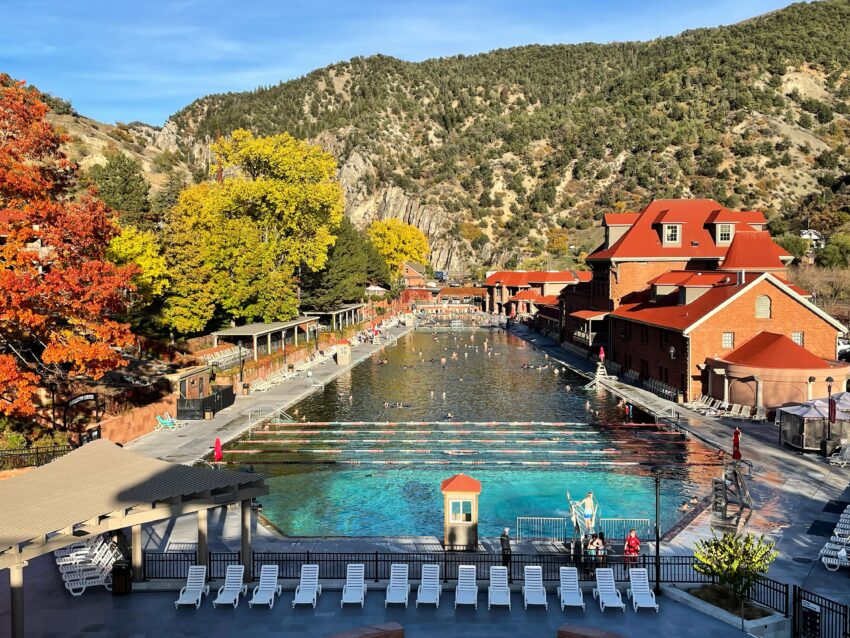
Glenwood Springs is too much fun to experience in one night. It deserves a stop on its own, with an adventure park, bicycling through the canyon, river running, and so much more.
If you have only one night, the world’s largest hot springs pool, a dozen fun restaurants and breweries, and a historic hotel (Hotel Colorado) where the “Teddy Bear” was created should get you through nicely.
Moab is unique. In 1859, Captain John N. Macomb of the U. S. Corps of Topographical Engineers explored the area where Moab would be and wrote, “I cannot conceive of a more worthless and impractical region.”
A hundred years later in the 1950s, writer Edward Abby was one of three employees at Arches National Park and wrote in his book Desert Solitaire, “This is the most beautiful place on earth.”
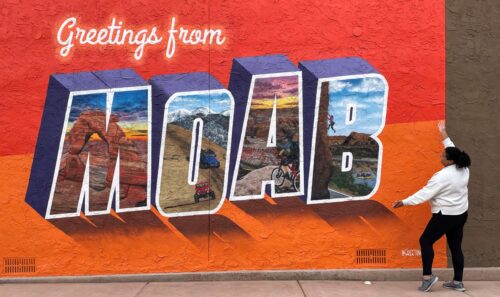
When I was in Moab in October 2021, the headline in the local paper was about the National Park Service starting an experimental timed-entry reservation system in 2022 because, in high season, Arches National Park is full almost every day.
When the number of cars entering the park matches the number of parking spots, the park closes (usually around 9 or 10 am), it doesn’t reopen until cars start leaving.
Of course, it’s worth getting up early to get in, but that system is not sustainable, and eventually, the park will be full before dawn.
An Alternative Arches Experience
An alternative to bringing your own car and just parking it at trailheads is to enter the park on group tours that go to all the sites and offer expert commentary on history and nature.
You can sit back and concentrate on the scenery, get to all the trailheads, do the famous hike to Delicate Arch, and more, all without adding another emissions-spewing, two-ton car to convey you around and take up a parking spot.

The Rocky Mountaineer offers packages with Southwest Adventure Tours, which have vans with glass roofs that are so much better for viewing the scenery than a car.
There are a dozen other activities in Moab besides the national parks, from rafting and kayaking to mountain biking, to a sport new to me – rock crawling. I can safely say it’s the scariest thing I have ever done. I happened to be in a Jeep driven by local legend Woody Bascom, who has been rock crawling in Moab for 25 years and was driving that day for Outlaw Adventure Tours.
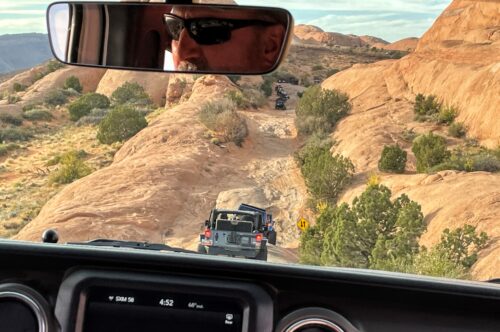
The sensation is much like a roller coaster. You know you are not going to die, but it’s disquieting that there are no real roads or trails.
Through an area of petrified sand dunes called “Hell’s Revenge,” we crept along in a Jeep/dune buggy over rocks and ledges with hundred-foot drops just inches away. When you look ahead, you see vehicles in the scariest positions you have ever seen a vehicle, and you know that in minutes that is going to be you in the same spot.
Well, it makes your wonderful seat back on the Rocky Mountaineer look even more inviting. And adventures like these are one reason why everyone should be happy that this Canadian tourism railroad has finally come to the United States.
For ticket pricing and information, visit Rocky Mountaineer.
- Galveston’s Horrible History - August 15, 2024
- Oklahoma City and the Protest Movement - February 15, 2024
- California, We Still Love You - August 31, 2023






I have traveled aboard the Mountaineer 3 times in Canada, loved it all. If I get a chance, I’ll sure want to ride it out of Denver. Great piece of writing, and the photos are also strong.
Great travel writing!
Would like to meet you.